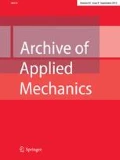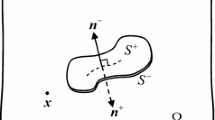Abstract
Dynamic stress intensity factors (SIFs) for a straight crack in a piezoelectric material under time-harmonic L- and SH-wave loading are determined for different electric boundary conditions. Impermeable, permeable and limited permeable cracks are compared. The problem is formulated and numerically solved using a nonhypersingular traction-based boundary integral equation method where the fundamental solution is obtained by Radon transform. A parametric study in the frequency domain shows the dependence of the SIFs on the choice of the electrical boundary conditions at the crack faces.
Similar content being viewed by others
References
Deeg, W.F.: The analysis of dislocation, cracks and inclusion problems in piezoelectric solids. PhD thesis, Stanford University, Stanford, CA (1980)
Pak Y.E.: Crack extension force in a piezoelectric material. ASME J. Appl. Mech. 57, 647–653 (1990)
Sosa H.: On the fracture mechanics of piezoelectric solids. Int. J. Solids Struct. 29, 2613–2622 (1992)
Pak Y.E.: Linear electro-elastic fracture mechanics of piezoelectric materials. Int. J. Fract. 54, 79–100 (1992)
Suo Z., Kuo C.M., Barnett D.M., Willis J.R.: Fracture mechanics for piezoelectric ceramics. J. Mech. Phys. Solids 40, 739–765 (1992)
Wang B.: Three-dimensional analysis of an ellipsoidal inclusion in a piezoelectric material. Int. J. Solids Struct. 29, 293–308 (1992)
Zhang T.Y., Hack J.E.: Mode III cracks in piezoelectric materials. J. Appl. Phys. 71, 5865–5870 (1992)
Park, S.B.: Fracture behaviour of piezoelectric materials. PhD thesis, Purdue University (1994)
Park S.B., Sun C.T.: Effect of electric field on fracture of piezoelectric ceramics. Int. J. Fract. 70, 203–216 (1995)
Wang B.L., Mai Y.-W.: A piezoelectric material strip with a crack perpendicular to its boundary surfaces. Int. J. Solids Struct. 39, 4501–4524 (2002)
Fulton C.C., Gao H.: Effect of local polarization switching on piezoelectric fracture. J. Mech. Phys. Solids 49, 927–952 (2001)
Wang B.L., Hau S.Y., Du S.Y.: New considerations for the fracture of piezoelectric materials under electromechanical loading. Mech. Res. Commun. 27, 435–444 (2000)
Wang B.L., Mai Y.-W.: On the electrical boundary conditions on the crack surfaces in piezoelectric ceramics. Int. J. Eng. Sci. 41, 633–652 (2003)
Parton V.Z.: Fracture mechanics of piezoelectric materials. Acta Astronaut. 3, 671–683 (1976)
McMeeking R.M.: Electrostrictive stresses near crack-like flaws. J. Appl. Math. Phys. 40, 615–627 (1989)
McMeeking R.M.: The energy release rate for a Griffith crack in a piezoelectric material. Eng. Fract. Mech. 71, 1149–1163 (2004)
Shindo Y., Ozawa E.: Dynamic analysis of a cracked piezoelectric material. In: Hsieh, R.K.T. (eds) Mechanical Modeling of New Electromagnetic Materials, pp. 297–304. Elsevier, Amsterdam (1990)
Shindo Y., Ozawa E., Nowacki J.P.: Singular stress and electric fields of a cracked piezoelectric strip. Int. J. Appl. Electromagn. Mech. 1, 77–87 (1990)
Ou Z.S., Chen Z.H.: Discussion of the crack faces electric boundary condition in piezoelectric fracture mechanics. Int. J. Fract. 123, L151–L155 (2003)
Wang X.D., Meguid S.A.: Effect of electromechanical coupling on the dynamic interaction of cracks in piezoelectric materials. Acta Mech. 143, 1–15 (2000)
McMeeking R.M.: Crack tip energy relase rate for a piezoelectric compact tension specimen. Eng. Fract. Mech. 64, 217–244 (1999)
Hao T.H., Shen Z.Y.: A new electric boundary condition of electric fracture mechanics and its applications. Eng. Fract. Mech. 47, 793–802 (1994)
Wang X.D., Jiang L.Y.: Fracture behaviour of cracks in piezoelectric media with electromechanically coupled boundary conditions. Proc. R. Soc. Lond. A458, 2545–2560 (2002)
Kuna M.: Finite element analyses of cracks in piezoelectric structures: a survey. Arch. Appl. Mech. 76, 725–745 (2006)
Parton V.Z., Kudryavtsev B.A.: Electromagnetoelasticity. Gordon and Breach Science Publishers, New York (1988)
Landis C.M.: Energetically consistent boundary conditions for electromechanical fracture. Int. J. Solids Struct. 41, 6241–6315 (2004)
Wippler K., Recoeur A., Kuna M.: Towards the computation of electrically permeable cracks in piezoelectrics. Eng. Fract. Mech. 71, 2567–2587 (2004)
Shindo Y., Narita F., Ozawa E.: Impact response of a finite crack in an orthotropic piezoelectric ceramic. Acta Mech. 137, 99–107 (1999)
Enderlein M., Ricoeur A., Kuna M.: Finite element technique for dynamic crack analysis in piezoelectrics. Int. J. Fract. 134, 191–208 (2005)
Zhang C.H., Gross D.: On Wave Propagation in Elastic Solids with Cracks. Computational Mechanics Publication, Southampton (1998)
Gross D., Rangelov T., Dineva P.: 2D Wave scattering by a crack in a piezoelectric plane using traction BIEM. J. Struct. Integr. Durab. 1, 35–47 (2005)
Wang C.-Y., Zhang C.H.: 2D and 3D dynamic Green’s functions and time-domain BIE formulations for piezoelectric solids. Eng. Anal. Bondary Elements 29, 454–465 (2005)
Rangelov T., Dineva P., Gross D.: Effects of material inhomogeneity on the dynamic behaviour of cracked piezoelectric solids: a BIEM approach. ZAMM 88(2), 86–99 (2008)
Rangelov T., Dineva P., Gross D.: A hypersingular traction boundary integral equation method for stress intensity factor computation in a finite cracked body. Eng. Anal. Bondary Elements 27, 9–21 (2003)
Balke, H., Kemmer, G., Drescher, J.: Some remarks on fracture mechanics of piezoelectric solids, In: Michel, B., Winkler, T. (eds.) In: Proceedings of the Micro Materials Conference, pp. 398–401, Micro Mat’97, Berlin (1997)
Gruebner O., Kamlah M., Munz D.: Finite element analysis of cracks in piezoelectric materials taking into account the permittivity of the crack medium. Eng. Fract. Mech. 70, 1399–1413 (2003)
Govorukhla V., Kamlah M.: Investigation of an interface crack with a contact zone in a piezoelectric bimatirial under limited permeable electric boundary conditions. Acta Mech. 178, 85–99 (2005)
Author information
Authors and Affiliations
Corresponding author
Rights and permissions
About this article
Cite this article
Rangelov, T., Dineva, P. & Gross, D. On the influence of electric boundary conditions on dynamic SIFs in piezoelectric materials. Arch Appl Mech 80, 985–996 (2010). https://doi.org/10.1007/s00419-009-0354-6
Received:
Accepted:
Published:
Issue Date:
DOI: https://doi.org/10.1007/s00419-009-0354-6



